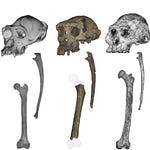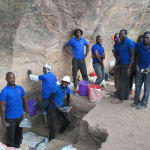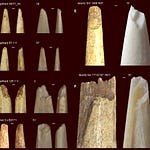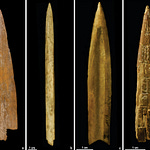In the shadow of South Africa’s southern coast, the archaeological layers of Blombos Cave have long preserved early expressions of symbolic life. Beads strung from seashells, abstract engravings on ochre, and ochre-stained toolkits have come to define the Middle Stone Age (MSA) as a formative chapter in the story of Homo sapiens. But a new study offers a shift in focus: not on what early humans adorned, but on what they shaped.
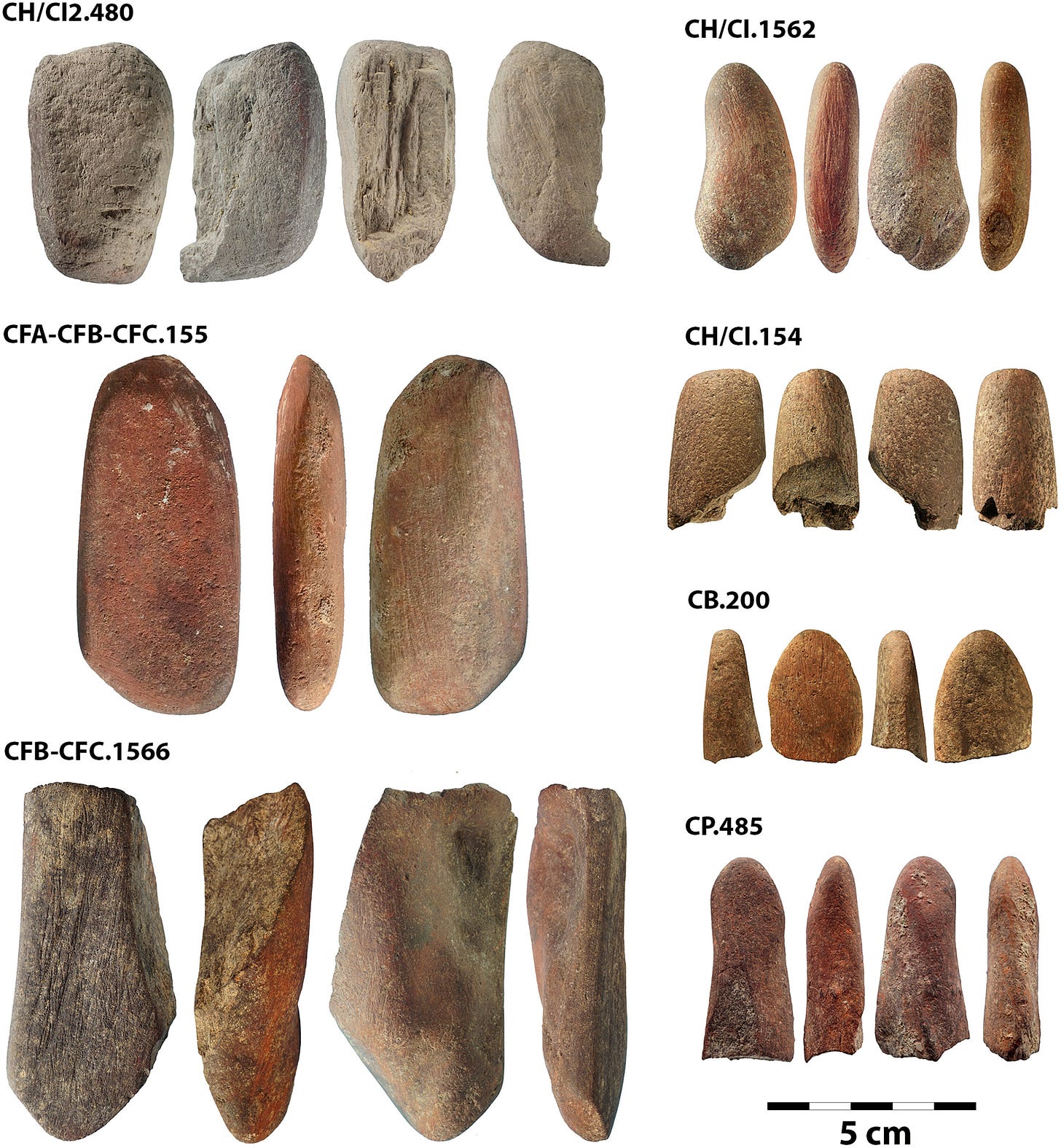
Between 90,000 and 70,000 years ago, residents of Blombos Cave weren’t just using ochre for decoration or ritual. They were shaping it into specialized tools. Tools not for scraping hides or painting walls—but for refining stone points with remarkable care. These ochre pieces were deliberately modified, carefully maintained, and wielded in a technical craft central to human survival: the making of stone tools.
“We now have direct evidence that ochre was being shaped and used as a retouching tool in lithic production,” said archaeologist Elizabeth Velliky, lead author of the study. “These were not casual or opportunistic implements. They were curated, rejuvenated, and built for purpose.”
A Toolkit Hidden in Plain Sight
The study, published in Science Advances1, documents seven ochre artifacts recovered from the deep layers of Blombos Cave’s Still Bay and pre-Still Bay deposits. Each piece bore signs of deliberate shaping—pecking, grinding, scraping—and use-wear consistent with either percussion-based or pressure flaking techniques.
What might seem like modest iron-rich stones, were in fact retouchers: tools used to refine the edges of stone blades. Some were ground to a point; others showed the impact scars and striations left by repeated contact with silcrete flakes. At least four were likely used in pressure flaking, a delicate technique demanding both fine motor control and an understanding of fracture mechanics.

Pressure flaking has been considered a hallmark of advanced toolmaking, one that didn’t appear widely until much later. Yet here it was, practiced in southern Africa by early Homo sapiens, tens of thousands of years before its proliferation in Europe.
"The sophistication of these tools implies a community of skilled individuals," said Francesco d’Errico, co-author and expert in cognitive archaeology. *"We are seeing technological knowledge passed down and refined over generations."
Not Just Any Ochre
The ochre artifacts didn’t come from a single moment in time. Some dated to the Still Bay period (~77,000 to 73,000 years ago), known for its iconic bifacial points and ornamental shell beads. Others came from older layers, including one piece—artifact CH/CI.154—with an almost perfectly elliptical form, marked by use and rejuvenation.
That piece, now broken, was shaped with such care that it likely belonged to a specialized toolmaker. It showed symmetrical striations on both sides, indicating it was used in a bidirectional manner. Pecking marks suggested it was intentionally shaped for durability and function.
"This wasn’t just a hunk of ochre used incidentally. It was engineered for retouching. That suggests foresight, expertise, and perhaps even ownership," said Velliky.
Rethinking the Role of Ochre
For decades, ochre has been studied primarily for its symbolic role. It was applied to skin, engraved with geometric designs, and used in burials. But its practical uses have often been relegated to the background or inferred from ethnographic analogy. This study provides direct archaeological evidence of ochre as a functional tool.
And not just functional—specialized. These artifacts were shaped to fulfill a single task: refining stone tools. This doesn’t rule out symbolic significance. The act of shaping ochre might have carried meaning, or these tools may have been imbued with social identity. But it expands the scope of what ochre meant in the MSA: it was material, medium, and machine.
Ochre, Identity, and Craft
If these tools were shaped and curated by individual knappers, they may also represent some of the earliest evidence of personalized technology. Their distinct forms, use patterns, and signs of rejuvenation suggest they weren’t shared casually. In a context where bone tools and shell beads have been interpreted as indicators of social roles, these ochre retouchers may tell a similar story.
"What we’re possibly seeing is the material signature of technical identity," said Karen van Niekerk, co-author and excavation director at Blombos Cave. *"An expert flint knapper might have carried their retoucher much like a modern craftsperson holds onto a favorite chisel."
The Implications of an Ancient Practice
Blombos Cave continues to offer one of the richest records for early symbolic and technological behavior in Africa. With over 8,000 ochre artifacts recovered, and more being analyzed, the cave is redefining how archaeologists think about early human cognition and craft.
This study opens the door for reinterpreting ochre at other sites—not just as pigment, but as a medium of shaping. It also strengthens the view that behavioral modernity didn’t arrive in a single burst, but through accumulations of skill, knowledge, and intention over time.
"The lines we draw between symbolic and functional behaviors are often too sharp," said Christopher Henshilwood, co-author and director of SapienCE. *"These artifacts sit at the intersection—they are tools, but they are also expressions of human thought."
Related Research:
d'Errico, F., & Stringer, C. (2011). "Evolution, revolution or saltation scenario for the emergence of modern cultures?" Philosophical Transactions of the Royal Society B: Biological Sciences, 366(1567), 1060-1069. https://doi.org/10.1098/rstb.2010.0340
Rosso, D. E., d’Errico, F., Queffelec, A. (2017). "Patterns of change and continuity in ochre use during the late Middle Stone Age of the Horn of Africa: The Porc-Epic Cave record." PLOS ONE, 12(5): e0177298. https://doi.org/10.1371/journal.pone.0177298
Watts, I. (2009). "Red ochre, body painting, and language: interpreting the Blombos ochre." In R. Botha & C. Knight (Eds.), The Cradle of Language. Oxford University Press.
Mourre, V., Villa, P., & Henshilwood, C. (2010). "Early use of pressure flaking on lithic artifacts at Blombos Cave, South Africa." Science, 330(6004), 659-662. https://doi.org/10.1126/science.1195550
Hodgskiss, T. (2013). "Ochre use in the Middle Stone Age at Sibudu, South Africa: Grinding, rubbing, scoring and engraving." Journal of African Archaeology, 11(1), 75–95. https://doi.org/10.3213/2191-5784-10243
Velliky, E. C., d’Errico, F., van Niekerk, K. L., & Henshilwood, C. S. (2025). Unveiling the multifunctional use of ochre in the Middle Stone Age: Specialized ochre retouchers from Blombos Cave. Science Advances, 11(26), eads2797. https://doi.org/10.1126/sciadv.ads2797


